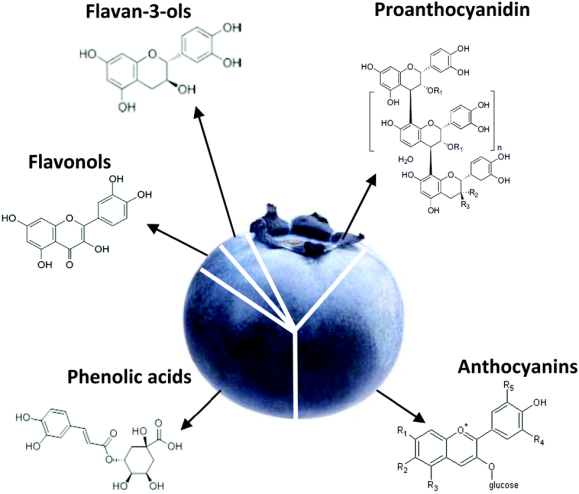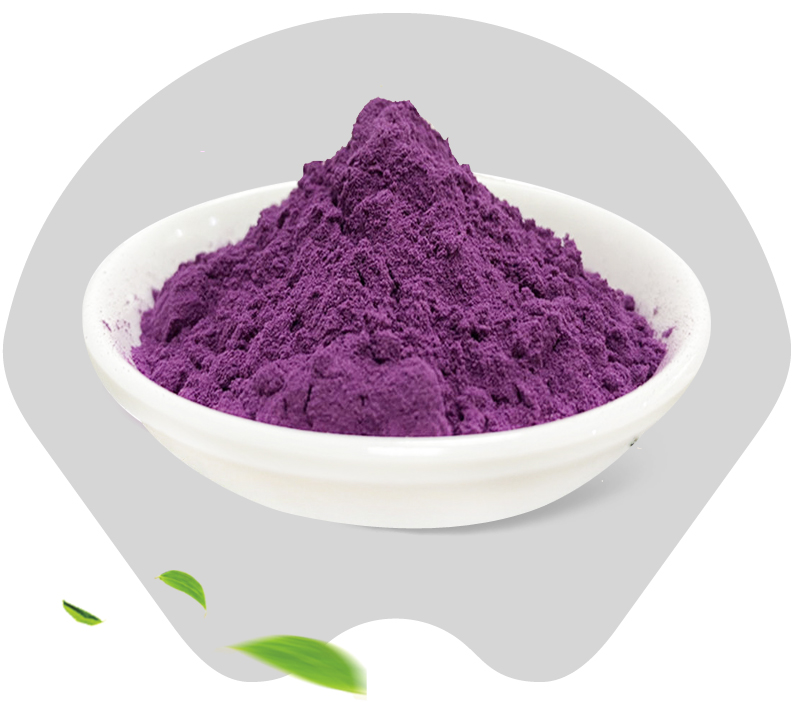
Anthocyanins are derived from flavonoids and are a large class of water-soluble plant pigment that displays a wide range of color diversity. The colors can change according to the pH value of the soil, and although they usually accumulate in flowers and fruits, they can be found in all types of vascualr plants and tissue. In the past decades, an increasing number of studies have investigated the protection and promotion effects of anthocyanins in several fruits and vegetables on human healt. By focusing on blueberries that are particularly rich in anthocyanin, the antioxidant activity was investigated and determined to be strong. Furthermore, dietary blueberries allegedly enhance vision and brain function, by enacting an anti-inflammatory role to attenuate projected chronic diseases (such as obesity and diabetes), simply through a prebiotic role that favorably regulates the gut microbial population.
The food industry also investigated the potential of anthocyanins as natural dyes, as concerns about the potential adverse effects of synthetic dyes have increased. The stability of anthocyanins in food and drink can be improved by using a derivatization protocol that polymerizes anthocyanins and creates stable colored by-products. Using an optimized protocol increases the color variability, but also increases the color intensity. Alternatively, the application of blueberry anthocyanins as natural colorants in other types of foods (cakes, yoghurts etc.) is limited because their resistance to processing conditions, formulation and storage conditions is relatively poor. The use of purified anthocyanin is also a problem because they become highly unstable and degrade quickly. To stabilize them,sodium alginate pectin hydrogel particles can be used to encapsulate the anthocyanins from blueberries, thereby enhancing the shelf life in aqueous solutions.
Blueberry anthocyanin species
Studies collectively demonstrate a high variation among blueberry cultivars for total anthocyanin content, although the determination method is different. Values range from 19.3 to 677.8mg cyanidin-3-glucoside per 100g fresh weight (FW), 456.7 to 1406.3mg cyanidin-3,5-glucoside per 100g FW, 44.3 to 417.7mg cyanidin-3-glucoside per 100g FW, and 101.88 to 195.01mg malvidin-3-glucoside per 100g FW. The differences in total anthocyanin content between cultivars could mainly be due to genotypes and environmental growing conditions (phenotypic plasticity). To the latter point, there are huge differences in the total anthocyanin content of the same cultivar grown in different environments. For example, the total cyanidin-3-glucoside content of ‘Bluecrop’ grown in Korea (227.2mg cyanidin-3-glucoside per 100g FW) is much higher than the same cultivar grown in the United States (19.3mg cyanidin-3-glucoside per 100g FW). ‘Legacy’ also has a large difference in total cyanidin-3-glucoside content in a Michigan crop (140.2µg cyanidin-3-glucoside per 100g FW) by comparison with the same cultivar grown in Oregon (68.4µg cyanidin-3-glucoside per 100g FW) of the United States. Indeed, growing conditions can alter the expression pattern of anthocyanin in blueberry crops. Furthermore, it is widely reported that the syntheses of anthocyanins and
other phenolic compounds are influenced by biotic and abiotic factors, such as
irradiation, temperature, soil pH, and pathogen attacks. However, the observed differences can also be considered as an artefact of the different extraction methods, or the different extraction solvents were used.
Test | Specification |
Appearance | Violet fine powder |
Odor | Characteristics |
Taste | Characteristics |
Assay (Anthocyanidins) | 25% Min |
Sieve Analysis | 100% Pass 80 mesh |
Bulk Density | 40-65g/100ml |
Loss on drying | 5% Max |
Sulphated Ash | 5% Max |
Heavy Metals | 20ppm Max |
Pb | 2ppm Max |
As | 2ppm Max |
Cd | 1ppm Max |
Hg | 1ppm Max |
Residual Solvent | 0.05% Max |
Total Plate Count | 10000CFU/g Max |
Yeast & Mold | 100CFU/g Max |
E.Coli | Negative |
Salmonella | Negative |
 CN
CN ENGLISH
ENGLISH



